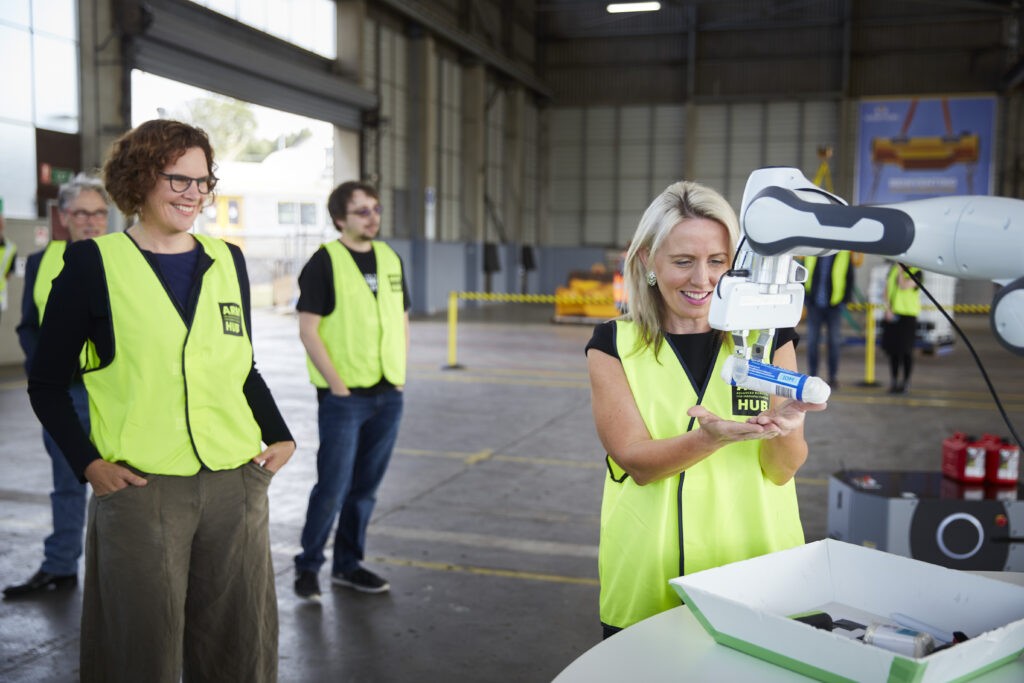Our Networks

Sharing and expanding knowledge with our research networks helps to ensure the best possible outcomes for the discipline of Robotic Vision
Publications and Presentations
In 2020, our researchers published a total of 238 papers, including 71 conference papers and 56 journal articles, and submitted a further 167 papers. See the 2020 Publications page for a full list.
Key publications included:
- “Semantics for Robotic Mapping, Perception and Interaction: A Survey” was published in Foundations and Trends® in Robotics. The paper was a result of twelve centre researchers spending 18 months reviewing over 900 papers. It was led by Centre PhD Graduate and Research Affiliate Sourav Garg and entailed a cross node collaboration from all four of the Centre’s partner universities involving Chief Investigators Niko Sünderhauf, Feras Dayoub, Michael Milford, Gustavo Carneiro, Qi Wu, Tat-Jun Chin, Ian Reid, Stephen Gould, Peter Corke, Research Fellow Akansel Cosgun and PhD researcher Douglas Morrison. The paper will be a fantastic resource for researchers in robotics and computer vision and provides a new taxonomy for considering semantics in robotics.
- Chief Investigator Hongdong Li and colleagues Dongxu Li, Cristian Rodriguez Opazo, and Xin Yu received the Best Paper Honorable Mention (Applications) Award at the 2020 Winter Conference on Applications of Computer Vision (WACV) for their paper titled “Word-level Deep Sign Language Recognition from Video: A New Large-scale Dataset and Methods Comparison”
- PhD researcher Jing Zhang and colleagues Deng-Ping Fan, Yuchao Dai, Saeed Anwar, Fatemeh Saleh, Tong Zhang, and Nick Barnes received a Best Paper Nomination for their paper “UC-Net: Uncertainty Inspired RGB-D Saliency Detection via Conditional Variational Autoencoders” at the Computer Vision and Pattern Recognition (CVPR) 2020 conference.
- PhD researcher Dongxu Li and colleagues Xin Yu, Chenchen Xu, Lars Peterson, and Hongdong Li, received a Best Paper Nomination for their paper “Transferring Cross-domain Knowledge for Video Sign Language Recognition“ at the Computer Vision and Pattern Recognition (CVPR) 2020 conference.
- Associated PhD researcher Zhiwei Xu and colleagues Thalaiyasingam Ajanthan, Vibhav Vineet, and Richard Hartley received a Best Student Paper Award for their paper “RANP: Resource Aware Neuron Pruning at Initialization for 3D CNNs” at the International conference on 3D Vision (3DV) 2020.
- Chief Investigator Rob Mahony, Associate Investigator Jochen Trumpf and colleagues Minh‐Duc Hua, Tarek Hamel, and Pascal Morin were awarded the 3rd Kimura Best Paper Award of the Asian Journal of Control for their paper “Feature-based Recursive Observer Design for Homography Estimation and its Application to Image Stabilization”.
We led academic, government, industry and business community meetings and presentations, bringing the complex world of robotic vision to a wide audience.
Key presentations included:
- Chief Investigator Dana Kulić gave an invited lecture titled “Estimating Human Objectives from Action and Interaction” at the International Federation of Automatic Control World Congress in July.
- Chief Investigator Gustavo Carneiro gave keynote presentations at the 12th biennial Frontiers Conference (Frontiers 2020), the 2020 Specialists sharing Expertise, Education and Data (SEED) symposium, and at the 5th Advanced Imaging Masterclass (AIM) presenting on Endoscopic Pathways, Diagnosis, Therapy, The Future.
- Chief Investigator Jon Roberts was on the SERVSIG 2020 Conference Panel for the discussion “How can we innovate by keeping humanity at the centre of service” in September.
- Chief Investigator Stephen Gould presented at the Australia-US National Science Foundation (NSF) MULTIPLIER videoconference on AI.
- Research Fellow Fatemeh Saleh presented “Uncertainty inspired solutions to stochastic problems via VAEs” at the Amirkabir AI Summer Summit (AAISS)
- Chief Investigator Michael Milford was the moderator for the Debates on the Future of Robotics Research for the IEEE International Conference on Robotics and Automation (ICRA). Michael was also an invited speaker for the Workshop on Reliable Deployment of Machine Learning for Long-Term Autonomy and moderator for the Workshop Benchmarking Progress on Self-Driving at the IEEE International Conference on Intelligent Robots and Systems (IROS).
- PhD researcher Violetta Shevchenko was a panel member for the “Understanding AI and Deep learning” talk at the Visual Question Answering and Dialog Workshop, during the 2020 Computer Vision and Pattern Recognition (CVPR) conference.
- Chief Investigator Elizabeth Croft was a panellist for the Royal Society of Victoria forum on “Possible Impossibles – unlocking how the role of science can shape our society.”
- Chief Investigator Qi Wu was the keynote speaker for the C4V workshop at the European Conference on Computer Vision (ECCV).
- PhD researcher Sadegh Aliakbarian gave a talk for the University of Bristol entitled “Learning to generate diverse human motions”, and a virtual talk for the Disney Research Studio in Zurich, entitled “Generative modeling of natural human motion”.
- Associate Investigator Thierry Peynot was an invited keynote speaker at Robotics and Automation in Mining held in February in Perth, and December in Brisbane
- Associate Investigator Liang Zheng gave a keynote talk “Do We Really Need Ground Truths to Evaluate A Model?,” at the Third International Workshop on Deep Learning for Pattern Recognition (DLPR20), during the International Conference on Pattern Recognition (ICPR) 2020.
- Chief Investigator Matt Dunbabin presented at COBOTS 2020: Intelligent and Collaborative Robotics and Automation Forum with his talk “How vision-equipped robots are saving the Great Barrier Reef.”
- Research Fellow Nicole Robinson gave a talk at the Brain Park Research Group; Melbourne Monash Consciousness Centre; 29th IEEE International Conference on Robot and Human Interactive Communication (RO-MAN); 12th International Conference on Social Robotics (ICSR 2020)
- Centre Director Peter Corke recorded a tutorial as part of the Review on Screw Theory & Geometric Robot Dynamics session, “A State-of-the-art Differential Geometry Algorithms for Robotics” for the International Conference on Intelligent Robots and Systems (IROS) 2020.
Workshops and Competitions
Our Robotic Vision Challenges continued in 2020 and two workshops were run as part of these challenges.
The Scene Understanding and Semantic SLAM: Progress, Applications, and Limitations workshop was a virtual workshop held during the International Conference on Robotics and Automation (ICRA) in June. The workshop focused on progress, applications and limitations and robotic scene understanding and semantic simultaneous localization and mapping (SLAM). The Beyond MAP: Reassessing the Evaluation of Object Detectors workshop was held as part of the European Conference on Computer Vision (ECCV) in August. It featured new evaluation methods for visual object detection and hosted the 3rd Probabilistic Object Detection Challenge which first featured at CVPR2019 and IROS2019.
ANU Researchers led the Deep Declarative Networks workshop at CVPR. Chief Investigators Stephen Gould, Richard Hartley, Research Fellow Dylan Campbell and Centre Alum and Former Research Fellow Anoop Cherian from the Mitsubishi Electric Research Laboratories. The workshop explored the advantages and potential shortcomings of declarative networks and their variants and discussed technical issues that need to be overcome in developing models and the applications of these models to computer vision problems that show benefit over conventional approaches. Invited speakers to the virtual workshop included: Brandon Amos (Facebook AI), Ricky TQ Chen (University of Toronto), Chelsea Finn (Stanford University), Pascal Fua (EPFL), Subhransu Maji (UMass Amherst), and Zico Kolter (CMU).
QUT Chief Investigators Feras Dayoub and Niko Sünderhauf were co-organisers of the Reliable Deployment of Machine Learning for Long-Term Autonomy workshop held during IROS 2020. The workshop focused on the problem of long-term autonomy for mobile robots and the challenge of building reliable machine learning components in the robotic system that can handle abnormal operational conditions, misclassification and detections. Keynote speakers at the workshop included: Nick Hawes (University of Oxford), Tim Barfoot (University of Toronto), Zhi Yan (UTBM), and Ben Upcroft (Oxbotica).
Centre researchers competed in the Open Cloud Robot Table Organisation Challenge (OCRTOC) at IROS 2020. The competition focused on the task of table organisation which is an essential capability for service robots. The competition involved two stages: simulation, and the real robot stage. Our ACRV Team included Research Engineers Steve Martin and Gavin Suddrey, Research Fellow Akan Cosgun, PhD researcher Jesse Haviland and Undergraduate students Rhys Newberry, Jun Kwan and Kerry He. The Team passed the simulation stage and evaluated their solution on the competition’s physical robot via a cloud service. The competition attracted 59 teams from industry and academia.
Centre researchers participated in key conferences in 2020 including:
- Conference on Computer Vision and Pattern Recognition (CVPR)
- International Joint Conference on Artificial Intelligence (IJCAI)
- International Conference on Robotics and Automation (ICRA)
- IEEE Winter Conference on Applications of Computer Vision (WACV)
- European Conference on Computer Vision (ECCV)
- Digital Image Computing: Techniques and Applications (DICTA)
- IEEE International Conference on Computer Vision (ICCV)
- IEEE/RSJ International Conference on Intelligent Robots and Systems (IROS)
- Australasian Conference on Robotics and Automation (ACRA)

The Centre’s Manipulation Demonstrator was created in 2020 and is designed to show-case manipulation research underway in the Centre, in an interactive and accessible way. Through the use of a touch screen interface and spoken verbal cues, the demonstrator invites members of the public to select from one of four interactive demos: a pick and place demo, in which the user selects an item on the screen for the robot to pick up and place in a different bin; a hand over demo, in which the user selects an item for the robot to pick and drop into the hand of the user; and a valve turning demo, in which the user selects from one of three valves for the robot to manipulate using compliant motion.
An important design requirement for the Demonstrator was the need for in-built robustness, with the intention of it being able to run unsupervised over extended periods of time.
During 2020, it was deployed to three different locations, including the Advanced Robotics for Manufacturing Hub (ARM Hub), The World of Drones and Robots Congress, and at QUT’s The Cube during a school holiday program. Over 1,000 people have engaged with the demonstrator, including the Honourable Minister Kate Jones, Queensland minister for State Development, Tourism and Innovation.
Feature image photo credit: metamorworks, iStock/Getty Images Plus